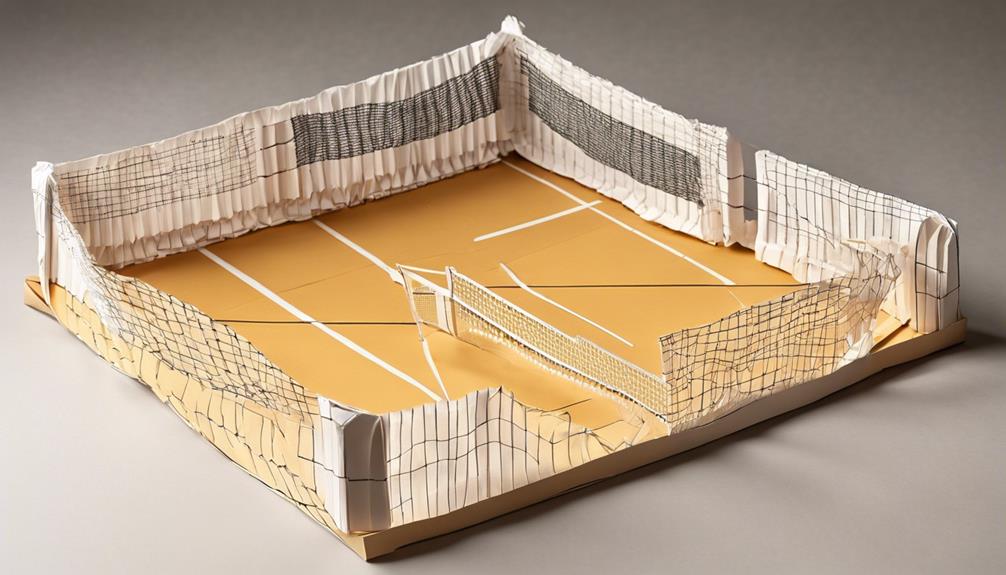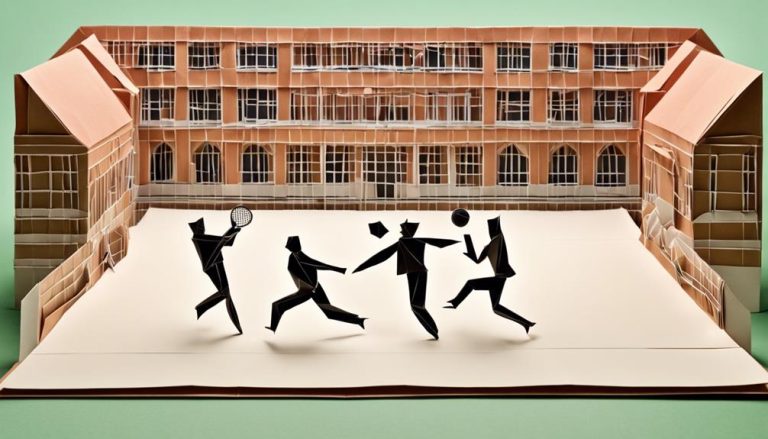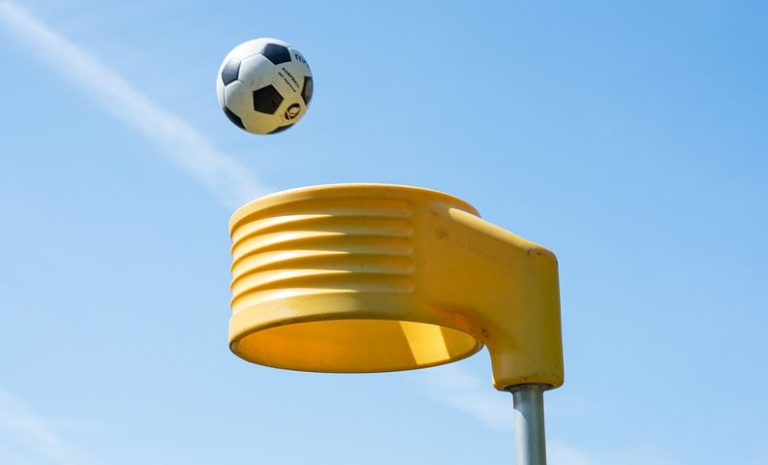General Rules of Sitting Volleyball
Did you know that sitting volleyball was first introduced in the Paralympic Games in 1980? As you navigate the court and learn about the general rules, you will discover the intricacies that make this sport both challenging and exciting. From team composition to serving rules, each aspect plays a crucial role in the game's dynamics. Whether you are a seasoned player or new to sitting volleyball, understanding these rules is essential for a successful match.
Court Dimensions

When playing sitting volleyball, make sure to familiarize yourself with the court dimensions to ensure fair play and strategic positioning. The court for sitting volleyball is smaller than a standard volleyball court, measuring 10 meters in length and 6 meters in width. Understanding the court dimensions is crucial for players to maximize their movements and effectively cover the playing area.
Line judge responsibilities in sitting volleyball include monitoring whether the ball lands inside or outside the court boundaries. Referee signals are essential for indicating faults, points, and rotations during the game. It's important for players to pay attention to these signals to understand the flow of the match accurately.
Regarding equipment requirements, sitting volleyball players use a lower net set at 1.15 meters for men and 1.05 meters for women. The ball used in sitting volleyball is the same as the one used in standing volleyball, but the playing surface characteristics are adapted to accommodate players sitting on the ground. Understanding these nuances can significantly impact a player's performance on the court.
Team Composition
Alright, let's talk about the key points when it comes to team composition in sitting volleyball. You'll need to understand player positions, the rules for substitutions, and the minimum player requirement for a team. These aspects play a crucial role in how a team operates effectively on the court.
Player Positions
To ensure a well-balanced and effective team composition in sitting volleyball, players are strategically positioned on the court based on their unique skills and abilities. Here are some key player positions and their roles:
- Defensive Specialist: Positioned in the back row, excelling in defensive strategies to receive and dig opponents' attacks effectively.
- Setter: Typically located in the middle front position, showcasing exceptional setting skills to assist in creating offensive plays and setting up hitters for successful attacks.
- Blocker: Found at the net, mastering blocking techniques to impede the opponent's attacks and create a solid defense.
- Attacker: Positioned at the front row, utilizing offensive tactics to spike the ball past the opponent's block and score points for the team.
Substitution Rules
For an effective team composition in sitting volleyball, understanding the substitution rules is crucial to maintain a dynamic and competitive lineup. Timing restrictions play a significant role in sitting volleyball substitutions. Teams are allowed unlimited substitutions but can only make them when they have possession of the ball or during intervals between sets. Player rotation is essential to ensure fair play and maintain the strategic balance within the team. Substitutions can have a profound impact on strategy as they allow for fresh energy and skills to be injected into the game. Furthermore, they influence team dynamics by providing opportunities for different players to contribute and showcase their abilities, fostering a sense of unity and collaboration among teammates.
Minimum Player Requirement
Understanding the substitution rules in sitting volleyball is crucial for maintaining a dynamic and competitive lineup, and an integral part of this is ensuring the minimum player requirement for team composition is met.
- Player Eligibility: Each team must have a minimum of 6 players on the court to start the game.
- Team Dynamics: Having the minimum number of players ensures that the team can function effectively, covering all necessary positions.
- Injuries: Meeting the minimum player requirement allows for substitutions in case of injuries, preventing the team from being short-handed.
- Strategic Advantages: A full team provides strategic options, such as rotating players to keep them fresh and adapting tactics based on the opponent.
Maintaining the minimum player requirement ensures that the team is prepared for any situation that may arise during the game.
Serving Rules
When serving in sitting volleyball, players must ensure the ball is contacted below the waist. Proper technique is key to a successful serve. Positioning plays a crucial role in executing a strong serve. By sitting stable with your core engaged, you can generate power and accuracy in your serves.
Serving strategy is vital in sitting volleyball. Communication among teammates is essential to coordinate your serves effectively. Discussing who will serve next and where to aim the serve can help maximize your team's performance. By working together and strategizing, you can create a strong serving rotation that keeps your opponents on their toes.
Net Height

Hey there! When it comes to net height in sitting volleyball, there are a few key points to consider. You'll want to know about the standard net height, any necessary adjustments for players, and the specific regulations followed in international competitions. Understanding these aspects will ensure fair play and a level playing field for all teams involved.
Standard Net Height
The standard net height in sitting volleyball is set at 1.15 meters for men and 1.05 meters for women. When considering net height variations, it's crucial to understand the strategic implications and player advantages involved. Here are some key points to keep in mind:
- Strategic Advantage: Adjusting the net height can impact the game strategy significantly, allowing teams to exploit certain weaknesses or enhance their strengths.
- Player Advantage: A lower net height can give players a better advantage in blocking and attacking, while a higher net height may favor defensive play.
- Fairness: Standardized net heights ensure fairness and equal opportunities for all players, regardless of gender.
- Regulation Compliance: Adhering to the specified net height regulations is essential for maintaining the integrity of the game.
Adjustments for Players
To optimize your performance in sitting volleyball, you can adjust the net height to suit your strategic objectives and individual strengths. Player equipment modifications can play a crucial role in this aspect. Lowering the net could favor players with exceptional blocking abilities, as it reduces the distance they need to cover. Conversely, raising the net might benefit players who excel in hitting powerful spikes from a higher position. These adjustments not only enhance your gameplay but also aid in injury prevention techniques. By customizing the net height to your advantage, you can create a competitive edge that maximizes your skills and minimizes the risk of strain or overuse injuries. Experiment with different heights during practice to find what works best for you.
International Competition Regulations
When competing internationally in sitting volleyball, the regulations regarding net height play a crucial role in ensuring fair play and standardized conditions for all teams.
- Consistent Height: The net height for international sitting volleyball competitions is set at 1.15 meters for men and 1.05 meters for women.
- Referee Signals: Referees will indicate if the net height needs adjustment during the match. Players should adhere to these signals promptly.
- Player Conduct: It's essential for players to respect the designated net height to maintain the integrity of the game.
- Fair Play: Spectators should appreciate the importance of the correct net height, while coaches can strategize around this regulation to optimize their team's performance.
Ball Handling

Mastering ball handling in sitting volleyball requires quick reflexes and precise control to effectively maneuver the ball during gameplay. When it comes to setting technique, ensure your hands are firm yet flexible, allowing for accurate placement of the ball to set up your teammates for successful plays. Defensive positioning is crucial; be ready to react swiftly to incoming balls and adjust your posture to maintain stability while making a play.
Passing accuracy is key in maintaining offensive momentum. Focus on angling your passes accurately to ensure your team can execute strategic attacks. Understanding offensive strategy is essential; anticipate plays and communicate effectively with your teammates to create openings in the opposing team's defense.
Scoring System
In sitting volleyball, understanding the scoring system is crucial for keeping track of points and determining the outcome of each match. The scoring system in sitting volleyball follows a similar format to standing volleyball but with slight modifications due to the nature of the game. Here are some key points to grasp about the scoring system:
- Rally Point System: Points can be won by either team on every rally, regardless of which team served.
- Game Format: Matches are usually played as the best of five sets, with each set played to 25 points. If a fifth set is needed, it is played to 15 points.
- Winning Margin: A team must win a set by at least two points unless the set reaches a designated cap (e.g., 25 or 15 points).
- Deciding Set: In a fifth set, teams switch sides when one team reaches 8 points to ensure fairness due to any court variations.
Understanding the scoring system can help players develop effective strategy tactics and adapt to the dynamic nature of the game. Additionally, incorporating proper athlete fitness and training techniques is essential for maintaining a competitive edge in sitting volleyball.
Rotation Regulations

Understanding the rotation regulations is essential for all sitting volleyball players to maintain game organization and strategic positioning on the court. Player behavior is crucial during rotations to ensure smooth transitions and adherence to the rules. Each team must follow a rotational sequence, moving clockwise when gaining the serve. This rotation system guarantees fair play and equal opportunities for all team members to contribute effectively. It also plays a vital role in game strategy, allowing teams to position players optimally to both defend against the opposing team's attacks and set up successful offensive plays. Players need to be disciplined in following the rotation order to avoid penalties and maintain the flow of the game. Strategic substitutions can also be made during rotations to enhance the team's performance based on specific match situations. By understanding and mastering rotation regulations, players can elevate their game and work together cohesively to achieve victory.
Faults and Violations
When it comes to playing sitting volleyball, it's crucial to be aware of the various faults and violations that can occur during the game. Here are some key points to keep in mind to avoid common mistakes and preventable errors:
- Illegal Blocks: Make sure your hands are not completely crossed the net into the opponent's space when blocking.
- Foot Faults: Avoid lifting your foot off the ground before contacting the ball when serving or during a play.
- Net Violations: Be careful not to touch the net with any part of your body while the ball is in play.
- Centerline Infringements: Stay mindful of not crossing over the centerline with any part of your body during the game.
Understanding and abiding by these faults and violations will not only ensure fair play but also contribute to a smoother and more enjoyable sitting volleyball experience. Keep these points in mind to play your best game and avoid unnecessary penalties.
Frequently Asked Questions
Can Players Switch Positions During a Sitting Volleyball Game?
Oh, sure, players can totally switch positions during a sitting volleyball game. It's not like teamwork dynamics or strategic planning matter at all. Just hop around, have a blast, and watch chaos reign supreme!
Are There Any Specific Rules Regarding Player Attire in Sitting Volleyball?
In sitting volleyball, when it comes to player attire, there are specific rules in place. Uniform requirements are essential to maintain fairness and professionalism, while equipment regulations ensure safety and consistency throughout the game.
How Are Disputes or Challenges Resolved During a Sitting Volleyball Match?
When disputes arise in sitting volleyball, line call issues or challenges can be settled through referee decisions. Sometimes video reviews are used to clarify the situation and ensure fairness in the match.
Are There Any Restrictions on Coaching or Communication Between Players During a Game?
During a sitting volleyball match, coaching restrictions are in place to ensure fair play. Player communication is essential for teamwork and strategy. Remember, support your teammates with words and actions, but coaching from the sidelines is limited.
Are There Any Specific Rules or Guidelines for Player Behavior or Sportsmanship in Sitting Volleyball?
Hey there! When it comes to player conduct and sportsmanship in sitting volleyball, remember that team dynamics and communication are key. Always show respect towards opponents, teammates, and officials, and strive for fair play.






